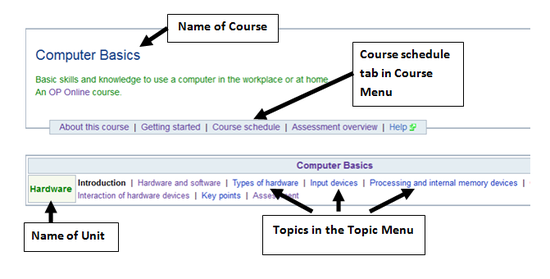Create and manage files/Getting Started
Contents
Getting started
Pre-knowledge
Before beginning this course, we recommend that you:
- ensure you have regular access to a computer and the internet
- be comfortable using a keyboard to input text and a mouse to click on objects
- keep linking the new content that you are studying with content in this course that you have already covered and with your own general knowledge, to deepen your understanding of the operations you are learning. If you have difficulty understanding any area, try working at it slowly. If you still do not understand, seek help.
Set yourself up for success
Before the course starts, work through these tasks to set yourself up for success:
| Item | Description |
| 1. Setup for success | |
| Review the course details |
It is essential that you review the course details. It contains the official course information, including the assessment guidelines. |
| Set aside regular study time |
It is important to give yourself enough time each week to do the learning activities and assessments. We recommend that you set aside specific timeslots each week that you can keep only for this course - for example, 10-12 on Tuesday, Thursday and Saturday. Then you will need to guard this time carefully! It would be best to choose a time of day that you are usually alert and work well, rather than one when you tend to be tired and not able to concentrate.
If you were doing this course in a classroom, you would have five hours of class time, and then be expected to set aside another seven hours to do readings, homework and assessments. While the amount of work required will vary, this is a good guideline to get started. If you have children, flatmates or other people who might interrupt your time you may need to plan ahead to get uninterrupted time - for example by arranging a babysitter, finding a place that you will not be disturbed, or agreeing that they will not interrupt you at these times. Working in a room where you can close the door - and putting up a "do not disturb" sign - can help. |
| 2. Familiarise yourself with the main course elements | |
| Online learning environment |
The learning environment for this course is based on open access readings and open educational resources, and is available fully online and self-directed. Further options for facilitation and assessment will be available in 2013. |
| Course schedule |
This shows the sequence of units and topics for each unit. It also provides a suggested number of hours to complete the learning activities and assessments for each unit. You can print out a copy of this page by selecting "Printable version" from the Wikieducator toolbox menu on the left and usng the Print function on your browser. Keep it handy to track your progress. |
| Course units |
You may find it useful to skim through an entire unit first, paying special attention to the headings and introductions, and then go through a second time for more in-depth study and practice. |
| Activities |
We recommend that you do the activities as they appear. They are essential study materials, offering practice in particular skills that will build your proficiency in computing. Skim through the learning activities to get a feel for what the course involves, and how activities support the portfolio activities (i.e. assessed tasks). Each activity provides links to the resources that you need to do that activity, such as readings and scenarios. We recommend that you use these resources when you are doing the activity. |
| Portfolio activities |
These assessed activities provide detailed guidance which will help you meet the requirements of this course. It is intended that you complete all portfolio activities, in more or less the prescribed sequence. |
| Forums |
If you choose the facilitated option of this course (coming 2013), the forums may be used by your facilitator to send general course announcements. You can also use this forum to request help from your facilitator. You can choose to automatically receive emails from the forums in this course. |
| Assessment |
If you choose the assessment option of this course (coming 2013), you may be required to (a) submit your completed assessment portfolio to your facilitator for marking and/or (b) complete an online quiz. |
How to work through each unit and topic
Each course is made up of a number of units. Each unit can be accessed from the Course schedule tab in the Course Menu at the top of each page. Click on the name of a unit in the Course schedule to take you to that unit. To work through each unit, click on each of the topics in the Topic Menu. It is highly recommended that you work through the units and topics in the order provided.
Where to get help
If you require assistance with using this site, please check the Help section of this course.

